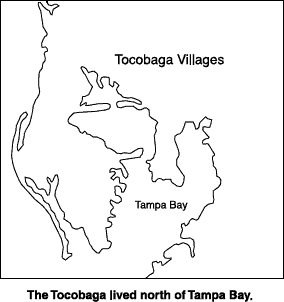Giant Tocobaga Indians
Ancient Bones, New Burial
A Tocobaga Indian’s Remains will be Returned to Sacred Ground
BY KAMEEL STANLEY Times Staff Writer
SAFETY HARBOR- In fall 2003, someone left a small, unwanted box on the doorstep of the Safety Harbor Museum of Regional History. No one thought anything of it for months, until, during a routine inventory of the artifact room, workers lifted the lid. What they found – a pile of human bones and several ancient artifacts – set off an effort that lasted nearly a year and determined the remains are those of a Tocobaga Indian who lived in the area as much as 1,100 years ago.
And so, after considering ways to handle the remains with dignity, the museum and a local American Indian group will bury them Saturday in a ceremony. “This is an unusual, rare proceeding,” said Walter Bowman, the museum’s educational director. “It’s something the public isn’t going to see, if ever, again.”
The Spirit People Intertribal Family, a multitribal group, is handling the burial. “Our burial grounds have been desecrated,” said Pamela Davidson, known as Waterbird, who is the group’s spiritual leader. “It is a great and tremendous honor for us to be asked to bring this ancestor back to where they belong.”
In a private, sacred ceremony early Saturday, tribal leaders will prepare the bones for their final resting place, a shell mound on the museum’s property. A holy man traveling from South Carolina is the only person allowed to touch the remains, which will be covered with a shroud out of respect.
But during the ceremony’s public part at 10 a.m., people will get to experience a seldom-witnessed traditional American Indian funeral service. Everything from the Cherokee language that will be spoken to the cultural dress and foods served afterward will be authentic, Davidson said.
Nicknamed by the first European explorers as “the Giants,” the Tocobaga Indians settled in the area around 900 A.D. and were known for their height, strength, and fine looks. Their diet consisted mostly of shellfish, hence the numerous shell mounds in Pinellas County. These mounds, called “midden,” were the tribe’s junkyards but became major cultural symbols.
The heavily tattooed people lived by three rules. “You couldn’t steal, murder, or commit adultery,” said Ron Fekete, in charge of the museum’s exhibits. “If you did any of those, you would be killed.”
At upward of 6 feet tall, the athletic Tocobaga towered over the Europeans who arrived in the early 1500s.
- Research done by Rephaim23


Comment